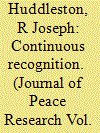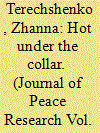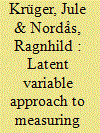|
|
|
Sort Order |
|
|
|
Items / Page
|
|
|
|
|
|
|
| Srl | Item |
| 1 |
ID:
176047


|
|
|
|
|
| Summary/Abstract |
How do self-determination groups move toward diplomatic recognition? Although recognition is the dominant activity used to understand international sovereignty, it is perhaps the most costly decision states make towards these groups. Third parties have many substantial interactions with aspiring states, building their sovereignty by other important means. I argue that our understanding of international sovereignty can be improved by conceptualizing it as a dynamic, continuous process, reflected in foreign policy decisions short of the legal recognition. I create a Bayesian latent variable model of international sovereignty, using bilateral data on diplomatic exchange, IGO voting, sanctions, military aid, and intervention in separatist conflicts. Complementing prior work on international sovereignty, my measure provides support for important theoretical expectations previously explored using only recognition as a measure of sovereignty. I find that diplomatic recognition, extant violence, separatist victory, and sour third-party–incumbent relations positively impact latent sovereignty of separatists, while concern for precedent negatively impacts it.
|
|
|
|
|
|
|
|
|
|
|
|
|
|
|
|
| 2 |
ID:
176045


|
|
|
|
|
| Summary/Abstract |
The majority of studies on international conflict escalation use a variety of measures of hostility including the use of force, reciprocity, and the number of fatalities. The use of different measures, however, leads to different empirical results and creates difficulties when testing existing theories of interstate conflict. Furthermore, hostility measures currently used in the conflict literature are ill suited to the task of identifying consistent predictors of international conflict escalation. This article presents a new dyadic latent measure of interstate hostility, created using a Bayesian item-response theory model and conflict data from the Militarized Interstate Dispute (MID) and Phoenix political event datasets. This model (1) provides a more granular, conceptually precise, and validated measure of hostility, which incorporates the uncertainty inherent in the latent variable; and (2) solves the problem of temporal variation in event data using a varying-intercept structure and human-coded data as a benchmark against which biases in machine-coded data are corrected. In addition, this measurement model allows for the systematic evaluation of how existing measures relate to the construct of hostility. The presented model will therefore enhance the ability of researchers to understand factors affecting conflict dynamics, including escalation and de-escalation processes.
|
|
|
|
|
|
|
|
|
|
|
|
|
|
|
|
| 3 |
ID:
176042


|
|
|
|
|
| Summary/Abstract |
Conflict-related sexual violence is an international security problem and is sometimes used as a weapon of war. It is also a complex and hard-to-observe phenomenon, constituting perhaps one of the most hidden forms of wartime violence. Latent variable models (LVM) offer a promising avenue to account for differences in observed measures. Three annual human rights sources report on the sexual violence practices of armed conflict actors around the world since 1989 and were coded into ordinal indicators of conflict-year prevalence. Because information diverges significantly across these measures, we currently have a poor scientific understanding with regard to trends and patterns of the problem. In this article, we use an LVM approach to leverage information across multiple indicators of wartime sexual violence to estimate its true extent, to express uncertainty in the form of a credible interval, and to account for temporal trends in the underlying data. We argue that a dynamic LVM parametrization constitutes the best fit in this context. It outperforms a static latent variable model, as well as analysis of observed indicators. Based on our findings, we argue that an LVM approach currently constitutes the best practice for this line of inquiry and conclude with suggestions for future research.
|
|
|
|
|
|
|
|
|
|
|
|
|
|
|
|
|
|
|
|
|